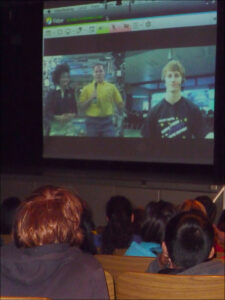
LINCOLN MIDDLE SCHOOL — More often than not, when an administration calls a school assembly, it's to give a long-winded but well-intentioned talk on self-esteem or the dangers of alcohol and other substances.
When one of the first images to pop up on the huge pull-down projector screen was an upside down woman floating next to a man in zero gravity, any notions of a "typical" morning were quickly dispelled.
Lincoln Middle School was one of 24 schools across the nation on Thursday to participate in a teleconference with astronauts on the International Space Station.
The program was a collaboration between the Student Spaceflight Experiment Program, the National Center for Earth and Space Science Education, NASA and the U.S. Department of Education to inspire young people to engage in math and science.
Each school was allowed to ask a question to either Space Station Commander Sunita Williams or astronaut Kevin Ford as they floated in space, or Leland D. Melvin, Earth-bound at the National Air and Space Museum in Washington, D.C.
The astronauts have heard of Lincoln before.
The school earned the opportunity to join the conference after a team of students won a national competition that put one of their experiments on board the SpaceX Dragon capsule, a private vessel that took supplies to the International Space Station in early October.
Astronauts were tasked to make Silly Putty in the zero-gravity environment using materials provided by students in a 10-inch Teflon tube. Students will get a chance to compare their putty to that made in space to see if the radically different conditions result in changes to the substance.
Several of those involved in the experiment — Alexander Soohoo, Dean Chien and Francis Abastillas — had a front row seat to Thursday's presentation.
"I'm shocked, it's humbling," Abastillas said.
Lincoln students watched as the scene from the Smithsonian National Air and Space Museum appeared in front of them. After a brief introduction by Deputy Secretary of the Department of Education Tony Miller, the real stars of the party — the astronauts — appeared on the screen.
"Houston, this is station. We are ready for the event," a voice cracked over the sound system.
The two figures appeared on the screen, Williams upside down from the perspective of the kids in the audience. Ford quickly attempted to break the illusion of direction in zero gravity.
"I would tell you my commander is upside down, but maybe the camera is upside down, and I am," Ford said.
Then the questions began.
How do you contact your family on Earth? What do you do with your spare time? What was your first ah ha! moment?
The astronauts shared the challenges of moving around in space without gravity to hold one to the ground, or performing medical maneuvers like chest compressions if pushing against the victim only forces you away from their body.
The solution: Float upside down, place your feet against the ceiling and push downward, Williams said.
"It's a little like a dream, being here," Ford told the students.
Cole Pillar and Ksenia Zinkelvich, eighth graders at Lincoln, were tasked with the school's question. They'd each turned in a similar question, which was chosen out of hundreds of entries.
By that time, to the disappointment of many, the astronauts had turned off their feed and questions were being fielded by Melvin, who has also traveled in space.
"What is the most difficult thing to adapt to when you get to the (International Space Station), and when you get back," the pair asked.
Melvin's answer surprised them.
"Going to the bathroom, because everything in space floats," he said.
It wasn't quite what they were looking for, they said.
The presentation was the culmination of two years of work on the part of science teachers Marianna O'Brien and Carol Wrabel, who caught wind of the opportunity and went out seeking money to apply.
It takes $20,000 to get the experiment into orbit because you're effectively renting space on the International Space Station, a pricey endeavor by all accounts.
O'Brien submitted the original grant to the California Space Grant Consortium out of UC San Diego in August 2010. She received word roughly four months later that the project had been approved.
This was a year before the students who would eventually send their project into space would even attend an eighth grade class at Lincoln, but the consortium decided to put its money behind the students and the teachers, said Tehseen Usman Lazzouni, assistant director of the California Space Grant Consortium.
The Lincoln application won in part because it came with a plan to disseminate information about the project beyond the eighth grade and touch hundreds of students in the process.
"It was a big decision for us, but we felt we could reach out to so many students," she said.
With money worries aside, O'Brien and Wrabel went to the students. They received 400 submissions right off the bat, and roughly 20 students put in the time every day after school — sometimes until 7 p.m. — working on their projects.
A Santa Monica selection panel pared that number down to three, which were sent off to the National Center for Earth and Space Science Eduation, which selected the winning Silly Putty experiment.
"Silly Putty captured people's attention," Wrabel said. "Every kid has played with Silly Putty."
The experiment is expected to come back down to Earth by next week, at which point the students will be able to open it up and compare the space-bound putty to the normal kind.
The whole process captured the imagination of the kids, and has been a wonderful opportunity, Wrabel said.
"The piece that's most exciting is that these kids have never experienced anything like this, and they never will again," Wrabel said.
ashley@www.smdp.com









